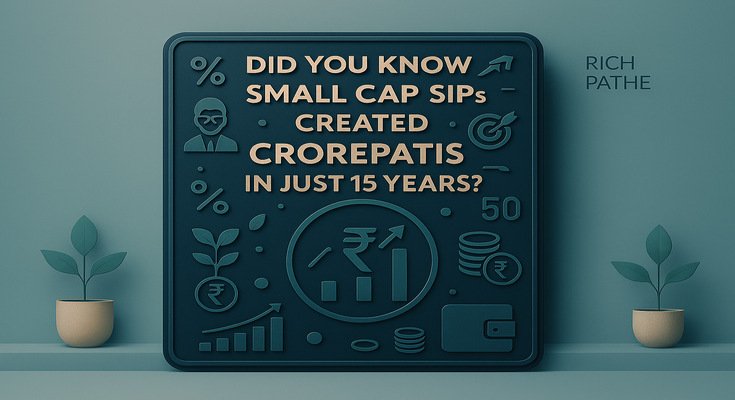Did You Know Small Cap SIPs Created Crorepatis in Just 15 Years?

When people talk about wealth creation through the stock market, one term often stands out – Small Cap SIPs. These little-known investment gems have turned ordinary investors into crorepatis in just 15 years. Sounds unbelievable? Let’s break it down step by step and see how SmallCap SIPs work, why they are powerful, and how you can benefit too.
What Are Small Cap SIPs?
Before diving deep, let’s simplify the concept.
- Small Cap Funds are mutual funds that invest in small-cap companies – firms ranked 251st and below by market capitalization. These companies are often young, growing, and have high potential for expansion.
- A SIP (Systematic Investment Plan) allows you to invest a fixed amount regularly, say monthly, in such funds.
When you combine the growth potential of small-cap companies with the discipline of SIP, you get SmallCap SIPs – a wealth-building machine.
How Small Cap SIPs Created Crorepatis in 15 Years
Here’s an example:
Imagine you invested ₹10,000 per month in a SmallCap SIP 15 years ago.
- Total Investment = ₹18 lakh
- Average Annual Returns (historical) = 18%–22% CAGR
- Final Corpus = Over ₹1 crore
This means consistent investing, patience, and the power of compounding helped small investors achieve crorepati status. That’s why financial planners say, Small Cap SIPs can be game changers for long-term wealth creation.
Why Small Cap SIPs Deliver High Returns
Small-cap companies are like hidden treasures. They start small but often grow rapidly as they expand into new markets, launch innovative products, and attract investors.
Here’s why Small Cap SIPs have historically outperformed large-cap and mid-cap SIPs:
- High Growth Potential – Small-cap companies can double or triple in size faster.
- Market Discoveries – Investors gradually recognize their potential, pushing valuations up.
- Compounding Advantage – A disciplined SIP allows you to buy at different price levels, averaging costs.
- Patience Pays Off – Over long horizons, short-term volatility doesn’t matter, and long-term growth dominates.
This is why many investors who stayed invested in Small Cap SIPs for 12–15 years became crorepatis.
Risks of Small Cap SIPs – What You Should Know
Of course, it’s not all rosy. While Small Cap SIPs offer higher returns, they also come with risks:
- Volatility – Prices swing more during market crashes.
- Liquidity Risk – Smaller companies may not have enough buyers/sellers.
- Management Risk – Some small-cap companies fail to scale.
👉 The good news? A SIP strategy reduces risk by investing gradually and averaging out market fluctuations. Over the long term, the volatility smooths out, leaving investors with wealth creation.
Who Should Invest in Small Cap SIPs?
Small Cap SIPs are not for everyone. They suit:
- Investors with a long-term horizon (10–15 years)
- People who can handle short-term ups and downs
- Young investors aiming for aggressive wealth creation
- Anyone who wants to diversify beyond large-cap blue-chip stocks
If you fall into this category, Small Cap SIPs could be your golden ticket to financial freedom.
Best Practices to Succeed with Small Cap SIPs
To truly benefit, follow these strategies:
- Start Early – The earlier you begin, the more time compounding works.
- Stay Consistent – Never stop SIPs during market crashes; that’s when you buy cheap.
- Diversify – Don’t invest 100% in small caps; balance with large and mid-cap funds.
- Review Periodically – Rebalance your portfolio every 2–3 years.
- Patience Is Key – Wealth creation takes time; don’t chase quick profits.
By following these steps, Small Cap SIPs can turn your financial goals into reality.
Real-Life Example – How Small Cap SIPs Change Lives
Take the case of Ramesh, a 30-year-old software engineer. In 2008, he started a Small Cap SIP of ₹10,000 per month. Fast forward 15 years, his investment of ₹18 lakh grew to over ₹1.1 crore.
Today, Ramesh uses this corpus to buy his dream house and fund his daughter’s education. His success proves that with discipline, Small Cap SIPs can truly create wealth.
FAQs on SmallCap SIPs
Q1: Are Small Cap SIPs safe?
SmallCap SIPs are relatively riskier than large or mid-cap funds due to volatility. However, with a long-term horizon, the risks reduce, and the rewards can be huge.
Q2: How much should I invest in SmallCap SIPs?
Experts suggest allocating 10–20% of your total portfolio to smallcaps for aggressive wealth creation.
Q3: Can SmallCap SIPs make me a crorepati?
Yes! Historical data shows that investing ₹10,000 monthly in SmallCap SIPs for 15 years has turned many investors into crorepatis.
Q4: What’s the ideal time frame for investing in SmallCap SIPs?
At least 10–15 years. Smallcaps need time to grow, and long-term patience helps ride out market volatility.
Q5: Which is better – Lump Sum or SIP in SmallCap Funds?
SIPs are better since they average out the cost and reduce the impact of volatility.
Final Thoughts
The stock market has countless opportunities, but not all of them can transform your wealth the way SmallCap SIPs can. In just 15 years, disciplined investors have achieved crorepati status by consistently investing in small-cap funds.
Yes, they carry risks, but with patience, discipline, and diversification, the rewards are unmatched. If you’re young, ambitious, and willing to stay invested for the long haul, SmallCap SIPs could be your stepping stone to financial independence.
So, ask yourself – are you ready to let SmallCap SIPs make you the next crorepati in the coming decade?
If you’re ready to explore more such financial tools, visit Richpath.in for expert insights, wealth-building ideas, and simple strategies for smart investing.
Read more –
Did You Know SIP Returns Beat Fixed Deposits by 2x Over 10 Years?
Did You Know You Can Start a Mutual Fund SIP with Just ₹100?
Did You Know Sensex Gave Over 500x Returns Since 1979?
Did You Know Compounding Is Called the 8th Wonder of the World?
Did You Know Nifty 50 Outperformed Gold in the Last 15 Years?








